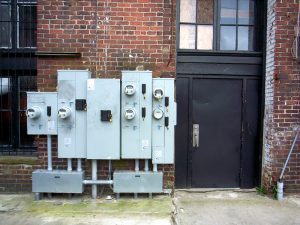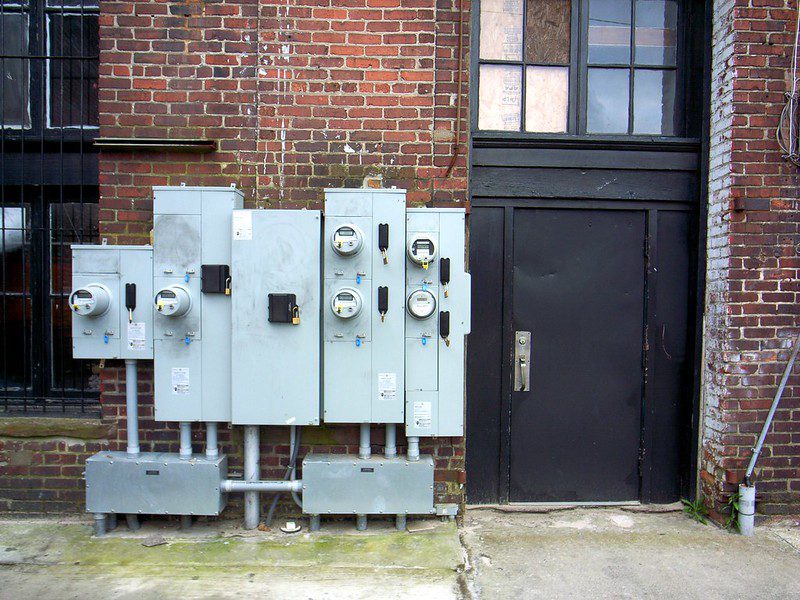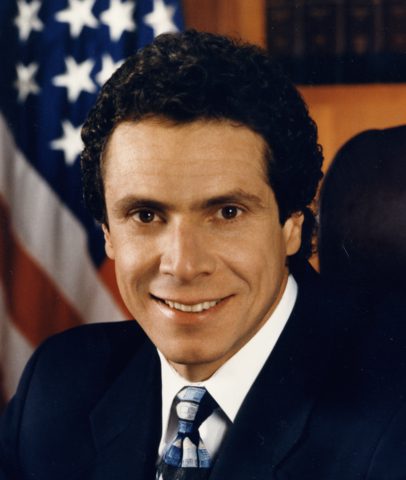
Photo by Flickr user Nicolas Nova, CC-BY-NC-2.0
Energy Policy Hurts The Poor
Energy costs are one major, if not the major, operating cost to many low-income households. More than 1 million households in 47 states and the District of Columbia with incomes less than $46,000 would pay over 30 percent of their income for winter heating if it were not for federal fuel assistance, according to a 1994 study done by Dr. Michael Sheehan (Scappoose, Oregon). Roughly 1.9 million households would pay more than 20 percent of income. More than 2.7 million households would pay over 10 percent of income, the ceiling of “affordability.”
Promoting affordable energy bills is one necessary component of any strategy to address the sustainability of overall shelter affordability. It makes little sense, and is ultimately unsuccessful, to address the affordability of housing simply by making downpayments smaller and monthly mortgage payments affordable. A household must not only be able to afford to purchase a home, but must be able to afford to operate that home as well.
Inability-to-pay translates directly into the loss of utility service for nonpayment. In 1992, 5.3 million households had utility service involuntarily disconnected for nonpayment. The number of people losing service is thus significantly greater, assuming two or more people per household.
Energy efficiency helps address inability to pay. Wisconsin Gas reduced low-income arrears by 300 percent through its low-income weatherization program. Connecticut Light and Power reduced low-income arrears by $48 a month. Niagara Mohawk had stunning success with its low-income Power Partnership Program.
But energy efficiency has its limits. Studies by the National Consumer Law Center in North Carolina and Michigan found that even if 1) no new poor were to arise; and 2) no weatherized low-income unit would ever need to be reweatherized, at current levels of funding, it would take 100 to 150 years for all low-income units to be reached.
Moreover, that recent study of winter heating bills by Sheehan found that the lowest income households, which includes most LIHEAP recipients, pay from 50 to 200 percent of their income for winter heating bills. Even if these households had dramatic efficiency improvements, their inability-to-pay would remain. Usage cannot be squeezed low enough to make bills affordable for these households.
Solutions
There are, however, solutions. Utilities, regulators and government, acting individually and in concert, can make significant improvements in the interest of low-income households that will ultimately benefit us all.
Access to Service
Given the problems that low-income households face today with high energy bills, it is vitally important for policymakers to ensure that undue burdens are not placed on already overburdened households when they seek service. The problems that low-income households have with paying their current utility bills carry over to the payment of deposits as well.
The collection of a cash deposit is one means to gain protection against the potential loss of revenue through bad debt. A utility must justify its collection of deposits, however, in light of the costs inherent in obtaining and maintaining them.
For example, one failing in the determination of whether deposits should be sought is the use of third-party, non-utility, credit information to determine whether or not new applicants for service are creditworthy. Non-creditworthy households are required to post a cash deposit.
The use of third-party supplied credit information as a basis for making utility deposit decisions is a problem when that information does not include utility payment history. After rent and mortgage bills, consumers tend to pay their utility bills before paying anything else. Additionally, low-income consumers frequently acquire poor credit ratings by refusing to complete payments on installment purchases of defective or shoddy merchandise. Finally, a person who has never borrowed from a reputable institutional lender, or maintained a charge account at a large store, may have difficulty establishing that his credit is good. As a result, information from a credit reporting agency that indicates a lack of creditworthiness based on non-utility transactions does not provide useful information as to a customer’s likelihood of paying a home utility bill. Ensuring that low-income households can gain access to utility service is the first important step in a low-income agenda.
Discounted Rates
A second component to any regulatory response to low-income energy problems is to help low-income households maintain service once it is procured. This can be done by offering discounted rates.
The goal of a public utility commission as to low-income rates is to have a utility collect the greatest proportion of a current bill that it can from low-income households while minimizing the costs of collection. As the Vermont Department of Public Service warned in 1989 “charging a rate and collecting a rate are two separate actions. Simply because a utility charges a particular rate does not mean that the utility will ever collect that money from a low-income household. Second, even when a utility does collect the total bill from a low-income household, the utility often spends considerable sums in the very act of collection. The net stream of income is thus less than the total outstanding bill.”
In September, 1990, the Pennsylvania Public Utilities Commission held that “for the poorest households with incomes considerably below the poverty line, existing initiatives do not enable these customers to pay their bills in full and to keep their service. Consequently, to address realistically these customers’ problems and to stop repeating a wasteful cycle of consecutive, unrealistic payment agreements that cannot be kept, despite the best of intentions, followed by service termination, then restoration, and then more unrealistic agreements, we believe that new approaches like [rate discounts] should be tried.”
Energy Efficiency Improvements
A third component to low-income energy solutions involves utility-financed energy efficiency programs targeted to the poor. This is true because low-income households tend not to participate in utility-financed conservation programs. Therefore, they do not benefit from the “system-wide” savings generated by energy efficiency measures. Low-income ratepayers are paying “their share” of the costs, but are systematically excluded from receiving “their share” of the benefits. As a result, when a utility uses ratepayer money to finance energy efficiency measures, there is a direct income transfer from low-income households to households with moderate and upper incomes. The income transfer is clearly in the wrong direction.
Regulatory Protections
A fourth component of addressing low-income energy problems is to provide regulatory protections against actions that tend to irrationally and unreasonably inflate the cost of low-income energy. Protecting against the imposition of late fees is one such example.
To encourage timely payments, utilities impose late payment charges. Unfortunately, not only are these charges not effective in their stated purpose, but their adverse effects on low-income households can be substantial.
Late payment charges should reflect a delineation of the type of customers who are likely to be involved. A utility must recognize the differences that exist between habitual nonpayers. Nonpayers can be categorized into three primary groups. Households who “do not” pay because they “can not” pay represent the first group. These households are typified by extremely low-incomes and high bills as a percentage of their income.
Households who experience an ongoing mismatch between their utility cycle billing date and their receipt of public assistance comprise a second group of habitual late payers. The potential for this class to be sizeable is great. Those who depend on programs such as SSI or AFDC have no control over the date on which they receive their income.
Households who use late payment as a money management technique are the last group. In these cases, so long as the return on the funds not paid to the utility exceeds any resulting late payment charge, the customer will financially benefit from delaying payment as long as possible. These households are not likely to be low-income households. Households making this type of sophisticated financial calculation are not likely to include those households lacking in education.
Clearly, low-income households do not withhold payments toward their utility bills in order to gain a higher return by devoting their resources to alternative uses. Low-income households do not pay because they cannot afford to pay. Seeking to create an incentive to make prompt payments by making unaffordable bills even higher is not only ineffective, but ultimately counterproductive.
Unintended Discrimination
A fifth component of protecting low-income energy service is to ensure that rates and services are to be offered on a “non-discriminatory” basis. Unfortunately, the claim of “discrimination” is often used only as a shield by regulators and other ratepayers to stop income-based programs designed to protect the poor. Moreover, the claim of “discrimination” has often been confined to “rates” while discrimination in the provision of service has been largely ignored.
Anti-discrimination regulations should be applied particularly in the evaluation of the “service” practices of public utilities. State utility statutes should forbid not only overt discrimination in rates, but also the more subtle forms of discrimination, inadvertent or otherwise, in the areas of disconnections, deposits, payment plans, and late charges and the like. The same principles that are used to evaluate claims of discrimination in ratemaking should be used to evaluate claims of service discrimination.
Cash Fuel Assistance
Some households simply lack the money to pay for their necessities, including energy. The average income of a LIHEAP household is below $6,000 in 17 of the 48 states reporting data in the 1994 Sheehan report cited above. Even in the remaining areas, the average annual income of a LIHEAP recipient falls between $6,000 and $8,000 in 23 states. Nationwide, nearly one in five fuel assistance recipients had annual income of less than $4,000.
To look only at average incomes and energy burdens is to miss one of the most significant parts of the story of LIHEAP. Clearly, households at the lowest ranges of income, by definition, need fuel assistance the most. Consider, for example, that without LIHEAP, the lowest winter home heating burden in any state – excluding Hawaii, Florida and California – would be nearly 50 percent for households in the lowest income range (less than $2,000). Texas, where this burden would arise, has almost 75,000 households – more than 16 percent of its total fuel assistance population – who fall into this income range.
Cash assistance serves a purpose, and a population, that no amount of energy efficiency investment, or winter protections, or regulatory protections and the like, would be able to serve. These households simply need additional resources to pay their home heating bills.
Winter Moratorium
Finally, low-income households should be protected by utility commission regulations against cold-weather-induced death and illness. Such cold weather protections do not adversely affect utilities. Data from Pennsylvania indicates that the state’s winter moratorium has little impact on whether households develop greater arrears during the heating months. In other words, a household’s winter arrears would be no less without a winter moratorium than with the moratorium.
Comprehensive Solutions Are Needed
Low-income inability-to-pay for home energy bills is a concern that far transcends protecting people from freezing to death. Inability to pay contributes to homelessness, housing abandonment and neighborhood deterioration. Inability to pay energy bills can adversely effect the educational achievement of students from low-income households. Inappropriate attempts to force payment from those unable to pay increases utility expenses, and thus rates to all other utility customers.
Addressing low-income energy problems, however, involves more than simply providing cash fuel assistance. While cash assistance is unquestionably necessary, particularly during high cost winter months, a low-income agenda must include components that will provide energy efficiency improvements, access to service, discounted rates, the elimination of unintentional discrimination, regulatory protections against unreasonable charges and fees, and winter crisis shutoff protections.
- According to the National Center for Health Statistics, roughly 60,000 lives are lost each year due to problems associated with cold weather, including fires,
- carbon monoxide poisoning, pneumonia, influenza and
- hypothermia.
- A study of 7,400 children by Boston City Hospital found that the number of malnourished, low-weight children jumped dramatically following the coldest winter months.
- Separate studies in North Carolina and Washington State found that one-in-four households losing their heat to shutoffs for nonpayment relied upon portable electric or kerosene heaters as their alternative source of heating. According to the National Institute for Fire Prevention, however, fires caused by such heaters are five times as likely to result in a fatality than the average house fire.
- One study in Pennsylvania, confirmed by research in Kentucky, found that utility service terminations were not “a” cause, but rather the cause of homelessness in nearly ten percent of the cases
- A study in Philadelphia found that over five years, an average of 22 percent of the homes of residential natural gas customers in that city became abandoned within one year following service termination. The average for electric terminations was 32 percent.
Phones for Power in Central Maine
De facto discrimination against low-income households can occur in a variety of contexts when public utility actions are judged by an “effects test.” Central Maine Power Company’s story involves discrimination in their offer of payment plans. In this instance, CMP did not try to implement a program that overtly discriminated against low-income households. Nevertheless, the CMP practices did indeed discriminate against poor people because of program attributes that are unrelated to any compelling need of the utility.
The state of Maine has adopted a unique approach to the winter payment problems of low-income customers. Rather than adopting a “pure” winter moratorium, whereby disconnections of service are absolutely prohibited for income-eligible customers from November through April, Maine has adopted a two-pronged approach to winter shutoffs. The first prong requires utilities to make a reasonable effort to make personal contact with customers who are $50 or more in arrears. This “personal contact” may occur either by telephone or by a visit. The second prong is a system of payment plans. The Maine commission requires most utilities to offer eligible customers an opportunity to enter into a Special Payment Arrangement. Under this plan, a customer may pay less than the full amount of winter bills as they become due; the difference is then “made-up” in equal increments during the non-heating months. In the event that (1) no personal contact is made with the customer, or (2) personal contact is made and the customer and utility fail to agree on a payment plan, or (3) a payment plan is agreed to but is subsequently broken, a utility may seek to disconnect service even during the winter months so long as it first obtains approval from the Maine PUC’s Consumer Assistance Division.
A 1988 report for the Maine PUC, prepared by the National Consumer Law Center, found that these rules operated, however unintentionally, to discriminate against a discrete population of low-income households. The report found that 70 percent of the households for whom a winter disconnection was sought, and 80 percent for whom a winter disconnection was granted, lacked telephone service in their home. The study found that the homes without telephones did not have greater arrears than the remaining population.
The study found further that the structure of the utility’s collection procedures worked to exclude these households that lacked telephones. It found that a statistically significant difference existed in the number of “no-phone households” that arranged to make payments, that obtained public assistance, and that entered into payment plans. The study concluded: It would appear that households which lack telephone service do not have the same ability to undertake the basic activities necessary to maintain home heating. They cannot contact social service agencies for public assistance; nor can they contact their utility to make payment plan arrangements.
Based upon this analysis, the Maine PUC was urged to eliminate the source of discrimination, heavy reliance upon telephone collection techniques. The Maine utility had, in effect, made the presence of a telephone a prerequisite to maintaining energy service, establishing unintentional discrimination.
Read more at Part II.




Comments